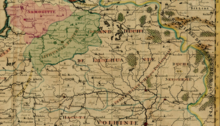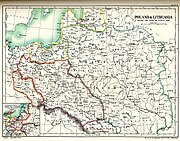
| Part of a series on the |
|---|
| History of Lithuania |
 |
| Prehistory |
| Middle ages |
| Early Modern era |
| Modern era |
| Other topics |
| Chronology |
|
|
Lithuania proper refers to a region that existed within the Grand Duchy of Lithuania where the Lithuanian language was spoken. The primary meaning is identical to the Duchy of Lithuania, a land around which the Grand Duchy of Lithuania evolved. The territory can be traced by Catholic Christian parishes established in pagan Baltic lands of the Grand Duchy of Lithuania subsequent to the Christianization of Lithuania in 1387. Lithuania proper (Lithuania Propria) was always distinguished from the Ruthenian lands since the Lithuanians differed from the Ruthenians in their language and faith (Paganism in the beginning and Catholicism since 1387). The term in Latin was widely used during the Middle Ages and can be found in numerous historical maps until World War I.
Lithuania proper is sometimes also called Lithuania Major, particularly in contrast with Lithuania Minor.
The Lithuanian geographer Kazys Pakštas wrote that Lithuania proper was known since the administrative division of the Grand Duchy of Lithuania in 1566, when the name was assigned to the palatinates of Vilnius and Trakai. The name was used in documents and maps. Lithuania proper also included the Duchy of Samogitia.
Evolution of the term
See also: Name of LithuaniaBefore the Grand Duchy of Lithuania

A few Baltic confederations from the second half of the 12th century and the 13th century are known.
Historians designate Lithuania proper (or the Land of Lithuania in a narrow sense) as a Lithuanian land that existed prior to Grand Duchy of Lithuania, near other lands: Land of Nalšia, Land of Deltuva, Land of Upytė. According to Henryk Łowmiański, Lithuania proper was in the nucleus of future Trakai Voivodeship between rivers: Nemunas, Neris and Merkys. Tomas Baranauskas suggests that Lithuania proper was around Ašmena area, ethnic Lithuanian lands in modern Belarus. According to Belarusian writer Mikola Yermalovich (although his reliability is questioned by scholars) Lithuania (Belarusian: Летапiсная Лiтва, literary: Lithuania of chronicles) was in the upper Nemunas region, now in modern Belarus.
In the Grand Duchy of Lithuania
Scholars often use the term Lithuania proper to refer to lands inhabited by ethnic Lithuanians as opposed to lands controlled by the Grand Duchy of Lithuania inhabited by Ruthenians (ancestors of modern Belarusians and Ukrainians), Poles, Lithuanian Jews or many other nationalities. Already during the Grand Duchy times, Lithuania proper was a term designated to land where Lithuanians live. Administratively, it consisted of Vilnius Voivodeship, Trakai Voivodeship and the Duchy of Samogitia. This division continued even after the Polish–Lithuanian Commonwealth was partitioned. Thus, the Grand Duchy of Lithuania was divided into the historical regions Samogitia (literally Lower Lithuania), Lithuania proper and Ruthenia.
Eastern part of Lithuania Propria
For centuries, eastern and southern lands of this territory, that had direct contacts with Ruthenia and Poland, initially inhabited by ethnic Lithuanians were slowly Ruthenised, Polonised and Russified, and the Lithuanian-speaking territory shrunk. Eastern parts of Lithuania Propria suffered heavy population losses during the Deluge, and further on during the Great Northern War and following plague epidemic in 1710–1711. Subsequent immigration of Ruthenians and Poles into these territories accelerated the process. A significant push to the de-Lithuanisation ensued when Lithuania became a part of the Russian Empire, and especially, after Lithuanian language books were forbidden to print in Latin letters in 1864. The process continued at the time of Polish rule, as Lithuanian language schools and libraries were closed, and later under Soviet rule, as no Lithuanian schools were in these territories at all. Nowadays significant "islands" of Lithuanian-speaking people remain in eastern and southern parts of Lithuania proper (modern Belarus (see Gervėčiai [lt] and Pelesa [lt] in Grodno Region) and Poland (see Punskas in Podlaskie Voivodeship). Many people of these territories now speaking Belarusian still refer to themselves as Lithuanians.
- Lithuania proper in maps
-
 Map showing territorial changes of Lithuania from the 13th century to the present day
Map showing territorial changes of Lithuania from the 13th century to the present day
-
 Area of the Lithuanian language in the 16th century
Area of the Lithuanian language in the 16th century
-
 Lithuania on a 1570 map
Lithuania on a 1570 map
-
 Polish–Lithuanian Commonwealth in 1700 with Samogitia (Samogitie), Lithuania proper (Vraye Lithuanie) and Lithuanian White Ruthenia (Russie Blanche ou Lituanique)
Polish–Lithuanian Commonwealth in 1700 with Samogitia (Samogitie), Lithuania proper (Vraye Lithuanie) and Lithuanian White Ruthenia (Russie Blanche ou Lituanique)
-
 1716 map of the Polish–Lithuanian Commonwealth with Lithuania proper (Vraye Lithuanie)
1716 map of the Polish–Lithuanian Commonwealth with Lithuania proper (Vraye Lithuanie)
-
 Map of Kingdom of Poland and Grand Duchy of Lithuania in 1720 with Lithuania proper
Map of Kingdom of Poland and Grand Duchy of Lithuania in 1720 with Lithuania proper
-
 18th century map of Poland–Lithuania with Lithuania proper
18th century map of Poland–Lithuania with Lithuania proper
-
 1733 map of the Kingdom of Poland and the Grand Duchy of Lithuania at the time of Augustus II the Strong with Lithuania proper
1733 map of the Kingdom of Poland and the Grand Duchy of Lithuania at the time of Augustus II the Strong with Lithuania proper
-
 Map of northern, central and eastern Europe in 1737 with Lithuania proper (Lithuanie Particuliere)
Map of northern, central and eastern Europe in 1737 with Lithuania proper (Lithuanie Particuliere)
-
 1773 map of the Polish–Lithuanian Commonwealth with Lithuania proper
1773 map of the Polish–Lithuanian Commonwealth with Lithuania proper
-
 1814 map of the partitioned Commonwealth with Lithuania proper (Duchy of Lithuania)
1814 map of the partitioned Commonwealth with Lithuania proper (Duchy of Lithuania)
-
 1883 map of the Polish–Lithuanian Commonwealth with Lithuania proper (Litwa)
1883 map of the Polish–Lithuanian Commonwealth with Lithuania proper (Litwa)
-
 1886 map of Poland and Lithuania during the 14th century with Lithuania proper (Litauen)
1886 map of Poland and Lithuania during the 14th century with Lithuania proper (Litauen)
-
 1888 map of Poland and Lithuania circa 1560, before the Union of Lublin (1569) with Lithuania proper
1888 map of Poland and Lithuania circa 1560, before the Union of Lublin (1569) with Lithuania proper
-
 1892 map of the Polish–Lithuanian Commonwealth between 1660 and 1667 with Lithuania proper
1892 map of the Polish–Lithuanian Commonwealth between 1660 and 1667 with Lithuania proper
-
 1910 map from the Historical Atlas of Poland with Lithuania proper (Litwa)
1910 map from the Historical Atlas of Poland with Lithuania proper (Litwa)
-
 1918 ethnographic map of Balts by the Leibniz Institute for East and Southeast European Studies with Lithuania proper and Lithuanian Ruthenia
1918 ethnographic map of Balts by the Leibniz Institute for East and Southeast European Studies with Lithuania proper and Lithuanian Ruthenia
Modern developments
At the end of World War I, the Council of Lithuania declared an independent Lithuanian state re-established in the ethnic Lithuanian lands.
After negotiations with Bolshevik Russia, a large part of Lithuania proper was acknowledged by Soviets as part of the Lithuanian Republic by signing the Soviet-Lithuanian Treaty of 1920. Some of these territories were also claimed by the Second Republic of Poland. This led to series of military conflicts and eventually to war.
In 1943, Antanas Smetona (in exile at the time) began working on a study "Lithuania Propria". The book was dedicated to the history of Lithuanian lands before Polonisation, Russification, and Germanisation, hoping that it would help to substantiate a claim to unreturned territories in a peace conference after World War II. His work was left unfinished, and for a long time was available only as a manuscript and was virtually unknown.
Currently the Republic of Lithuania has no territorial claims.
See also
Notes
- Latin: Lithuania propria; Lithuanian: Tikroji Lietuva, Didžioji Lietuva; Polish: Litwa ścisła, Litwa Właściwa or Litwa Rdzenna; Russian: собственная Литовская земля, lit. 'sobstvennaja Litovskaja zemlja' or Коренная Литва; Belarusian: Літоўская зямля, romanized: Litowskaja ziamla; Yiddish: ליטע, romanized: Lite; Danish: egentlig Litauen; German: Eigentliches Litauen; French: Lituanie propre
References
- ^ Gimžauskas 2001, p. 108.
- ^ Frost 2015, p. 67.
- Spečiūnas, Vytautas. "Didžioji Lietuva [Greater Lithuania]". Visuotinė lietuvių enciklopedija.
- Stone 2014, p. 4.
- "Legacy of Medieval Lithuania". Retrieved 26 September 2020.
- Gaučas 1986, p. 195-196.
- Safarewicz 1967, p. 257-259.
- Gudavičius, Edvardas. "Baltų žemių konfederacijos". Visuotinė lietuvių enciklopedija (in Lithuanian). Retrieved 10 March 2023.
- Gudavičius, Edvardas. "Lietuvių žemių konfederacija". Visuotinė lietuvių enciklopedija (in Lithuanian). Retrieved 10 March 2023.
- Gudavičius, Edvardas; Jasas, Rimantas. "Nalšia". Visuotinė lietuvių enciklopedija (in Lithuanian). Retrieved 10 March 2023.
- Baranauskas, Tomas. "Deltuva". Visuotinė lietuvių enciklopedija (in Lithuanian). Retrieved 10 March 2023.
- "Upytė". Visuotinė lietuvių enciklopedija (in Lithuanian). Retrieved 10 March 2023.
- Jasas, Rimantas. "Lietuva". Visuotinė lietuvių enciklopedija (in Lithuanian). Retrieved 10 March 2023.
- Baranauskas, Tomas (2002). "Kur buvo Lietuvos žemė?" (PDF). Lituanistica. 2: 3–18. Archived from the original (PDF) on 2007-09-28.
- Gudavičius, Edvardas (1996). "Following the Tracks of a Myth". Lithuanian Historical Studies. 1: 38–58. doi:10.30965/25386565-00101003. S2CID 231347582.
- Насевіч В.Л. Працэс утварэння Вялікага княства Літоўскага (13-14 стст.) // Актуальныя пытанні гісторыі Беларусі ад старажытных часоў да нашых дзён. Мн., 1992. С. 54-63.
- Виктор Верас. "Карта летапiснай Лiтвы". Archived from the original on 2011-07-23. Retrieved 2010-10-05. (in Belarusian)
- Виктор Верас. "У истоков исторической правды / Летописи о местонахождении Литвы". Archived from the original on 2010-10-08. Retrieved 2010-10-05. (in Russian)
- Venclova, Tomas. "Native Realm Revisited: Mickiewicz's Lithuania and Mickiewicz in Lithuania". Archived from the original on 2005-05-05. Retrieved 2007-04-24.
- Ochmański, Jerzy (1981). Litewska granica etniczna na wschodzie od epoki plemiennej do XVI wieku (in Polish). Wydawn. Nauk. Uniwersytetu im. Adama Mickiewicza. pp. 69–73. Retrieved 2006-04-26.
- (in Lithuanian) Viduramžių Lietuva Viduramžių Lietuvos provincijos Archived 2007-04-19 at the Wayback Machine. Retrieved on 2007.04.11
- Gimžauskas, Edmundas (2005). "LDK idėjos likimas XX a. Lietuvos bei Baltarusijos valstybingumų dirvoje" (PDF). Naujasis Židinys-Aidai (in Lithuanian): 528. Retrieved 10 October 2023.
- Authentic maps showing Lithuania Propria:
"Poloniae Regnum ut et Magni Ducatus Lithuaniae Accuratiss" (PDF). Retrieved 2007-04-22.
"Poloniae Regnum ut et Magni Ducatus Lithuaniae Accuratiss" (PDF). Retrieved 2007-04-22. - Savukynas, Viriginijus (2003). "Etnokonfesiniai santykiai Pietryčių Lietuvoje istorinės antropologijos aspektu". Kultūrologija. 10: 80–98. Retrieved 2007-12-11.
- Smetona, Antanas. "Lithuania Propria". Darbai ir dienos (in Lithuanian). 2 (11): 191–234.
- Aleksandravičius, Egidijus. "Istorija ir politika". Darbai ir dienos (in Lithuanian). 2 (11): 185–190.
- (in Italian)Claudio Carpini, Storia della Lituania: identità europea e cristiana di un popolo, Città Nuova, 2007, ISBN 978-88-31-10341-1, p.199
Sources
- Gaučas, P. (1986). "К вопросу о восточных и южных границах литовской этнической территории в средневековье" [On the issue of the eastern and southern borders of the Lithuanian ethnic territory in the Middle Ages] (PDF). Балто-славянские исследования (in Russian). Moscow: Nauka: 195–213.
- Gimžauskas, E. (2001). "The Belorussian Factor in the Genesis of the Modern Lithuanian State, 1915-1917". Lithuanian Historical Studies. 6 (1): 107–126. doi:10.30965/25386565-00601006. ISSN 1392-2343. S2CID 251242686.
- Stone, Daniel Z. (2014). The Polish-Lithuanian State, 1386-1795. University of Washington Press. ISBN 9780295803623.
- Frost, Robert (2015). The Oxford History of Poland-Lithuania. Vol. 1: The Making of the Polish-Lithuanian Union, 1385–1569. Oxford University Press. ISBN 978-0-19-820869-3. LCCN 2014948999.
- Safarewicz, J. (1967). Studia językoznawcze. Warszawa.
{{cite book}}: CS1 maint: location missing publisher (link)
| Lithuania articles | ||||||||||
|---|---|---|---|---|---|---|---|---|---|---|
| History |
|  | ||||||||
| Geography | ||||||||||
| Politics |
| |||||||||
| Economy | ||||||||||
| Society |
| |||||||||